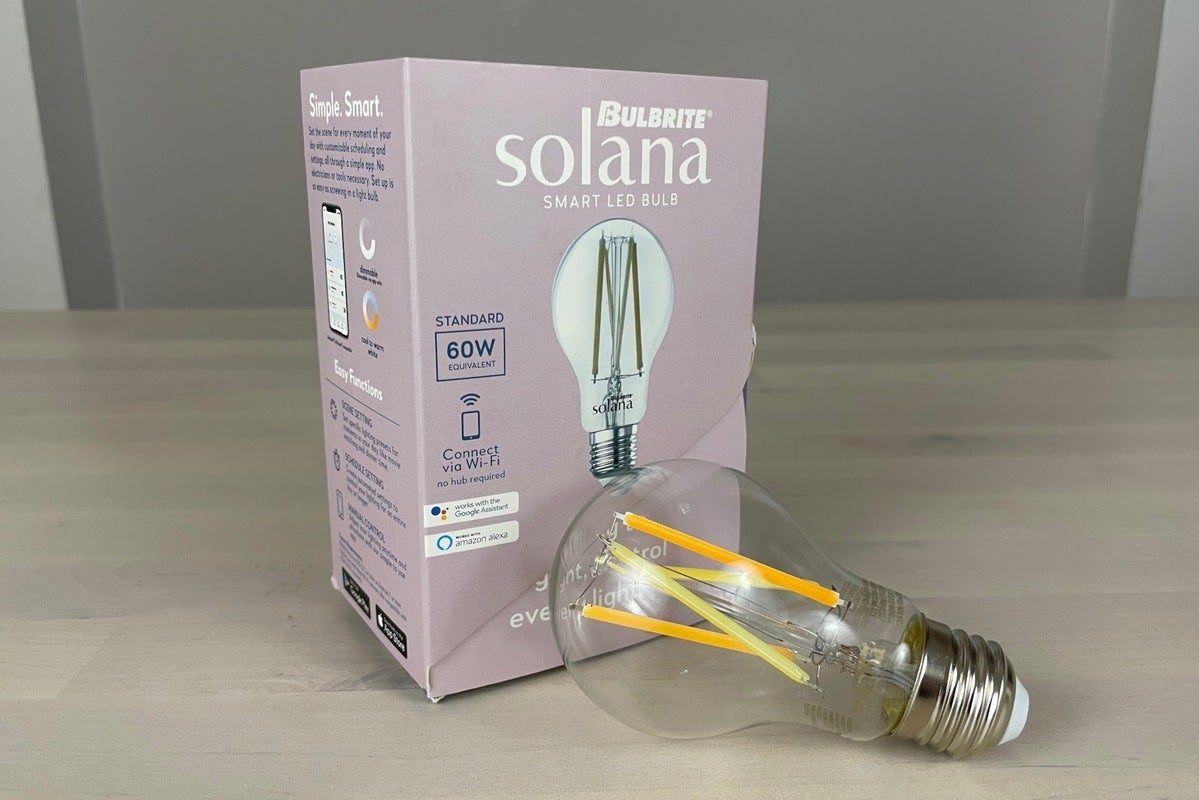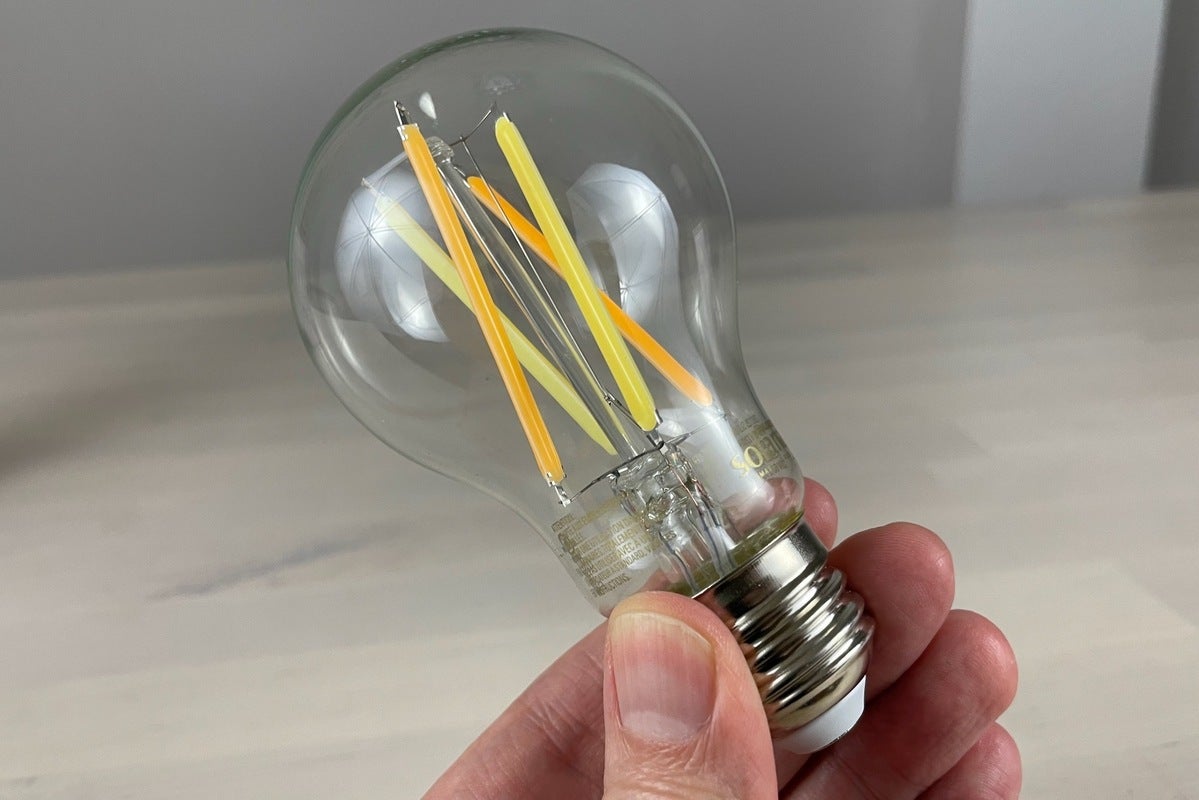Beginners and bargain hunters will warm to this reasonably priced smart filament bulb, but its lack of sleep/wake modes and IFTTT support will annoy savvier users.

Ben Patterson/IDG
Today’s Best Tech Deals
Picked by TechHive’s Editors
Top Deals On Great Products
Picked by Techconnect’s Editors
Bulbrite Solana Smart LED Filaments Tunable White A19
Show More
If you’re looking for an attractive, easy-to-use smart filament bulb that won’t break the bank, this inexpensive model from Bulbrite’s Solana line makes for a solid choice. Available for $20, The Smart LED Filaments Tunable White A19 is a Wi-Fi-enabled bulb that doesn’t require a hub, and unlike other smart filament bulbs in its price range, you can tune it from a warm white to a cool daylight temperature. Easy wireless setup and a sleek, intuitive app should please newcomers to the smart home market.
Some key features are missing, however, such as proper sleep/wake modes as well as a vacation mode. And while the Bulbrite Solana bulb does support Alexa and Google Assistant, it lacks support for Apple’s HomeKit and IFTTT.
This review is part of TechHive’s coverage of the best smart LED bulbs, where you’ll find reviews of the competition’s offerings, plus a buyer’s guide to the features you should consider when shopping this category.
Specifications
Bulbrite offers a variety of Solana-branded smart bulbs, including a standard A19 dimmable white bulb, a dimmable white BR30 floodlight, and a color A19 bulb (which we’ve previously reviewed). The brand also sells three smart filament bulbs, including a G25 globe, an Edison-style ST18 bulb, and the standard A19 bulb reviewed here.
The $20 sticker price for the Bulbrite Solana A19 filament bulb is relatively inexpensive compared to similar smart filament bulbs on the market, particularly given that its both dimmable and tunable. Philips Hue, for example, sells a dimmable but not tunable ST19 coiled filament bulb with Zigbee and Bluetooth connectivity for $25 (or $28 on Amazon), while LIFX has a dimmable, non-tunable Wi-Fi filament bulb for an even pricier $40.
The Bulbrite Solana A19 filament bulb has a familiar bulb shape and a standard E26 base, which will screw into most conventional light sockets. Rated to last up to 15,000 hours, the bulb’s white temperature can be tuned from a very warm 2,200 Kelvin to a cool 6,500K, which is the equivalent of daylight on a hazy day.
Inside the clear bulb are a quartet of straight (rather than coiled) filaments, two of which emit a warmer white temperature while the other two filaments shine with a cooler light. The two pairs of filaments will glow in various combinations to serve up the color temperature you’ve set in the Bulbrite Solana app (more on that in a moment).
 Ben Patterson/IDG
Ben Patterson/IDGThe Bulbrite Solana A19 filament bulb has four linear filaments, two of which glow in warmer white temperatures while the other two shine with cooler light,
Being the filament bulb that it is, the Bulbrite Solana A19 is better suited to setting a mood than lighting up a workspace, but it’s still relatively bright at 800 lumens, which is the equivalent of a 60-watt incandescent bulb. Cranking the bulb’s brightness all the way up in my darkened dining room, the Bulbrite Solana A19 filament bulb’s illumination was only adequate; but again, filament bulbs are more about style than utility.
Setup
The first step in adding the Bulbrite Solana A19 filament bulb to your Wi-Fi network is to download the company’s app and create an account (you’ll need to enter an email address and create a password). Next, the app will prompt you to screw in your new smart bulb, power it on, and ensure that it’s blinking rapidly, which means it’s in pairing mode. You’ll then need to enter your Wi-Fi password, and if all goes well (as it did for me, and refreshingly on the first try), the bulb should connect to your Wi-Fi router.
 Ben Patterson/IDG
Ben Patterson/IDGWhile the Bulbrite Solana A19 filament bulb is certainly attractive, it’s not bright enough to properly illuminate a workspace.
As with most smart bulbs, the Bulbrite Solana A19 filament bulb connects only to the 2.4GHz wireless band, which means you’ll probably need to disable the 5GHz band on your Wi-Fi router before connecting the bulb to your wireless network. Once the bulb is connected, however, you should be able to reactivate your router’s 5GHz band without any problems (I didn’t have any).
Features and functionality
The Bulbrite Solana’s mobile app is sleek and intuitive, unlike too many other smart bulbs app that are saddled with needlessly confusing interfaces. That’s the good news; the bad news is that its smart functionality is relatively limited, with some features—namely sleep and wake modes—failing to act as you might expect.
 Ben Patterson/IDG
Ben Patterson/IDGThe Bulbrite Solana app is sleek and easy to use, making it well suited for beginners.
For starters, you can control an individual bulb with an attractive, clearly designed interface with tabs for both brightness and temperature, while a large slider lets you dim and brighten the bulb or set warmer or cooler white temperatures. At the bottom of the interface is a prominent power button.
You can group Bulbrite Solana bulbs into various rooms in your smart home (“Bedroom,” “Office,” “Kitchen,” etc.), and once that’s done, you can change white and color temperatures (if you own a Bulbrite Solana color bulb), adjust the brightness, and change the power status of all the bulbs in a room simultaneously. You can also choose from more than a dozen group icons to make rooms within the app easier to identify.
Besides grouping bulbs together, the Bulbrite Solana app lets you create lighting scenes that you can trigger in schedules. For example, you could set up a scene that sets a pair of bulbs in your bedroom to a warm white temperature while dimming their brightness, while another scene could dial up various brightness settings, colors, and/or white temperatures for multiple lights in the same or different rooms. The whole process of creating a scene is easy: You just select the bulbs you want included, then adjust their settings, precisely as you would were you controlling the bulbs individually.
Setting a schedule is an easy process, if somewhat limited. You can set a custom schedule that turns a single light or a group of bulbs on and off, or you can set a schedule that triggers a lighting scene. Another option is to set an “away” schedule that douses your lights when you’re away from home, but you must schedule your “away” hours manually rather than via geofencing, and there’s no “vacation mode” that randomly turns your lights on and off.
There are also “wake up” and “go to sleep” schedules, but they don’t automatically gradually brighten or dim your lights; if you want to do that, you’ll need to set a series of schedules. For example, you could create a schedule that turns on your lights at 10 percent brightness at 6 a.m. on weekdays, then another schedule that ups the brightness to 20 percent at 6:05 a.m., and so on. That’s both annoying and disappointing. Luckily, you can easily set up genuine sleep/wake routines with the help of Alexa or Google Assistant. Speaking of which…
Smart home integrations
The Bulbrite Solana A19 filament bulb works with both Alexa and Google Assistant, which means you can add the bulb to a room within the Alexa and Google Home app, group it with other Alexa- or Google Assistant-controlled devices, add it to routines, and control it with voice commands.
You can also use Alexa and Google Assistant to fill a gap in the bulb’s feature set; namely, the ability to set “wake up” and “go to sleep” schedules. With Alexa, you can add the Bulbrite Solana bulb to a routine and then set it to gradually ramp up or dim its brightness. For Google Assistant, you can use the “gentle wake and sleep” feature to tell the Assistant to “sleep” the bulb at night (which gradually dims its brightness) or “wake” the bulb in the morning (which slowly increases the brightness). But if HomeKit is your smart home ecosystem of choice, you can’t do any of that.
Bottom line
The Bulbrite Solana Smart LED Filaments Tunable White A19 bulb has its drawbacks: it lacks native support for sleep/wake routines (although as we just noted, you can set these up with Alexa or Google Assistant), there’s no vacation mode, and there’s no HomeKit support (not too surprisingly given the bulb’s price point) nor IFTTT support (which is more disappointing).
Still, the Bulbrite Solana smart filament bulb is less expensive than we would have guessed given that it’s both dimmable and tunable, and the Bulbrite Solana app, while limited, is sleek and easy to use. If you can live with its limitations, the Bulbrite Solana Smart LED Filaments Tunable White A19 bulb makes for a solid, inexpensive choice.
Note: When you purchase something after clicking links in our articles, we may earn a small commission. Read our affiliate link policy for more details.
Bulbrite Solana Smart LED Filaments Tunable White A19
Beginners and bargain hunters will warm to this reasonably priced smart filament bulb, but its lack of sleep/wake modes, as well as HomeKit and IFTTT support will annoy savvier users.
Pros
- Easy to set up
- Intuitive app control
- Inexpensive for a tunable filament bulb
- Alexa and Google Assistant support
Cons
- “Wake up” and “go to sleep” modes don’t work the way you’d expect
- No vacation mode
- No HomeKit or IFTTT support
Ben has been writing about technology and consumer electronics for more than 20 years. A PCWorld contributor since 2014, Ben joined TechHive in 2019, where he covers smart home and home entertainment products.

